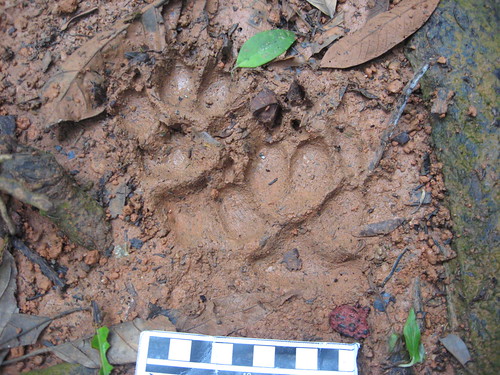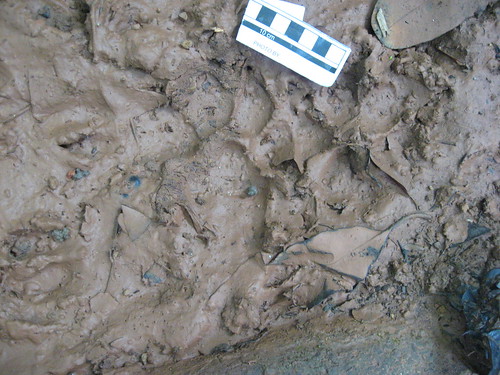How do I forget about fossils?
Well to put it simply it is because there aren't any. As I discussed in the previous post there is very little soil and if it isn't secured by roots it washes away quickly but I also mentioned that anything that dies in forest gets reused very quickly. For these reasons fossils are rare to nonexistent. You need to have sediment being laid down in order to preserve fossils and there are just too few areas in Costa Rica where this is occurring, although there are probably some I just don't know of any. This means that the fossil record for animals that lived and evolved in Costa Rica tends to be pretty sparse. That is not to say there isn't the potential for fossils to be found, after all the crew at the University of Florida have several sites in neighboring Panama where work is being done to widen the canal so who knows what the future holds.
Back on topic!
 The presence of big cats in Costa Rica should come as no surprise after all the Jaguar ranges from Mexico, rarely the U.S. Southwest, through most of South America. What actually surprised me was the presence of Pumas, or Mountain Lions/Cougars/etc, in Costa Rica because when I think of them I think of the Western U.S. My surprise aside, I was sad to hear that our second night there there was going to be a talk at the hotel about the big cats [photo at left of most likely Ocelot footprints, by author] in the region but we were already scheduled for another tour. After confirming that the people giving the talk would be back later we were relieved and so a few nights later my wife and I sat down for what would be a very interesting talk.
The presence of big cats in Costa Rica should come as no surprise after all the Jaguar ranges from Mexico, rarely the U.S. Southwest, through most of South America. What actually surprised me was the presence of Pumas, or Mountain Lions/Cougars/etc, in Costa Rica because when I think of them I think of the Western U.S. My surprise aside, I was sad to hear that our second night there there was going to be a talk at the hotel about the big cats [photo at left of most likely Ocelot footprints, by author] in the region but we were already scheduled for another tour. After confirming that the people giving the talk would be back later we were relieved and so a few nights later my wife and I sat down for what would be a very interesting talk.
The talk was given by Aida Bustamante from the conservation group Yaguará. The group is trying to make sure that the big cats in Costa Rica continue to be protected and can flourish. The research that the group has done is impressive and Aida gave an interesting talk, my wife and I were glad to have gone and told her so afterward.
The group has been working to try to change people's minds about the big cats. They have approached this in a couple of ways. The first way is by putting out camera traps around the national park as well as at many of the ecolodges. The ecolodges protect their forests because they know that is what brings tourists to them when a big group of these are located near each other, like on the Osa Peninsula they allow for animals to cross vast expanses of land like they would have before humans started cutting down the forests. The Osa Peninsula has plentiful forests and the big cats love it this allows for the presence of ocelots and pumas as well as other large cats and hopefully the jaguars. Giving talks like the one I attended is a way to reach these tourists to help protect these areas.
 Another way they are trying to protect the cat is through community outreach. This is done in two main ways the first is giving talks, like the one I saw, to the community and let them know the cats are out there but they are not very likely to hurt people [Photo to right of footprints potentially of a Puma I am actually unsure but based on size and shape that is what my wife and I decided, by author]. This includes not just going to schools but going to people's homes an places of work to give the talks. The other way is by paying ranchers the cost of any livestock that is killed by the big cats. This prevents the ranchers from going out to kill the animal that killed their livestock in a hope to recoup some of the loss, something that ranchers even here in the U.S. do.
Another way they are trying to protect the cat is through community outreach. This is done in two main ways the first is giving talks, like the one I saw, to the community and let them know the cats are out there but they are not very likely to hurt people [Photo to right of footprints potentially of a Puma I am actually unsure but based on size and shape that is what my wife and I decided, by author]. This includes not just going to schools but going to people's homes an places of work to give the talks. The other way is by paying ranchers the cost of any livestock that is killed by the big cats. This prevents the ranchers from going out to kill the animal that killed their livestock in a hope to recoup some of the loss, something that ranchers even here in the U.S. do.
Evidence of big cats is everywhere on the Osa, as noted by the two photographs on this post, and the camera traps have captured evidence of all of the big cats including jaguars. The jaguars need vast expanses of territory to roam, however, so they cannot just be confined to the Osa. Evidence from camera traps suggest that they have traveled to another national park across the bay from where we were. This is a good sign but the possibility remains that they could eventually get cut off. Prior to the 2008 economic downturn there were plans in the work the keep the areas connected by forest and allow this forest to be part of a larger transnational forest that runs most of Central America down to South America. When everyone's economy crashed in 2008 this was put on hold. Now there is talk of the President of Costa Rica opening up forest land to mining and farming, this would obviously hurt the ranges of the big cats.
But there is hope! As I mentioned the big cats are traveling and this wasn't heard of until recently so this is good news. The number of cats seems to be increasing and their prey items so to also be seeing a rise which means there are likely to be more cats to prey on these animals.
I hope that by raising attention to this issue here someone outside will notice. I went to Costa Rica because of the rain forest. This area represents a wild that we don't get to see here in the U.S. or Europe and I would hate to see that changed. Dollars often speak louder than words and my dollars were spent on things that allowed me to see the wildlife while down there. Enough about me is there anything you can do to help? Well you can write the government down there and let them know if you have been, are going to, plan to, or just want to go to Costa Rica and let them know how you feel about this topic. You can also donate to Yaguará, also see here, or other organizations that are working on preserving the Costa Rican environments. While we were down there the group Yaguará was selling T-shirts whose proceeds went to them so they could purchase more equipment.
As I mentioned earlier this is the last post in this series so I hope that you enjoyed it. If you didn't I'm sorry, I guess, but we will get back to normal posts, YouTube science videos and random comics with some actual though involving posts thrown in randomly, here shortly. As always feel free to leave comments in the comments below or send me a message!

No comments:
Post a Comment